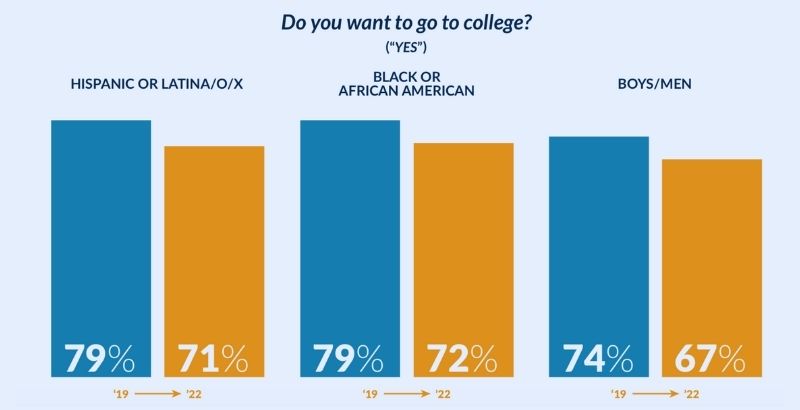Survey: 1 in 4 High School Seniors Changed Post-Graduation Plans Due to COVID
New YouthTruth data shows boys and Black and Hispanic students are less interested in college than 2019’s graduates

Get stories like this delivered straight to your inbox. Sign up for The 74 Newsletter
Milwaukie High, near Portland, Oregon, is known as a “safe school,” said Principal Carmen Gelman. Sharing space with the Milwaukie Academy of the Arts, the school draws students who struggle with anxiety as well as LGBTQ students who might feel unwelcome elsewhere.
After two years of a pandemic, Gelman is proud that her students have learned to speak up for themselves. For example, they asked for a room in the school to gather when they’re feeling emotionally overwhelmed. But as seniors prepare to graduate, she said it’s “been like pulling teeth” to keep them focused on academics.
“They wanted teachers to stop giving them homework,” she said. “Their priority is their mental health, not college.”

The pandemic’s impact on this year’s graduates is captured in new survey data showing that one in four seniors has changed their future plans because of COVID, and some have less desire to continue their education. Published Wednesday by YouthTruth, a San Francisco-based nonprofit, the data shows English learners, LGBTQ youth and students of color were more likely to reconsider their next steps. The results are based on responses from over 28,000 high school seniors from both 2019 and this year, allowing for comparison to the last senior class to graduate before the pandemic.
Black and Hispanic students and boys, for example, are less likely to say they want to go to college than those who graduated in 2019. Eighteen percent of this year’s graduates said they considered dropping out. But that rate was much higher among LGBTQ students (26%) and transgender students (37%). And Hispanic students are more likely than white students to say they’re unsure about their next steps — 14% compared with 9%.
Less access to college and career counseling could be one reason for the shift in attitudes.
In 2019, 40% of graduates reported receiving guidance from their schools about career pathways, according to the YouthTruth results. Among students in this year’s class, 33% said they received such guidance. And the percentage of students saying there’s an adult they could ask to write a college recommendation letter declined for males, students in rural schools and Hispanic students.
‘I felt like I was all alone’
Seniors told The 74 they felt reluctant to seek help and that counselors sometimes didn’t offer guidance unless asked.
Yan Kyaw, a senior at Senn High School in Chicago, said his school partnered with OneGoal, a nonprofit focusing on preparing students for higher education. But he had a hard time taking advantage of the help while learning remotely.
“I did have a support system, but I didn’t use them because I felt like I was all alone,” said Kyaw, who will attend the University of Illinois Chicago and study business. In junior year, he didn’t ask for feedback on his college essays. He often found himself sitting on his bed, staring at the ceiling. He described his high school years as “a punch in the gut.”
Due to the pandemic, many seniors went without the kind of volunteer and internship experiences colleges often look for and had fewer in-person college fairs and opportunities to “set their feet on a college campus to do a tour,” said Geoff Heckman, head of the counseling department at Platte County High School, near Kansas City, Missouri.
Students have “done their best to pick next steps based upon virtual tools and online information,” he said, “but without the genuine face-to-face conversation that is so helpful in making that determination about which direction they really want to pursue.”

Rajsi Rani, who’s graduating from Orange County School of the Arts in Santa Ana, California, said she missed informal communication the most.
“Because everything was virtual, there was no knowledge passed by word of mouth, which I’ve found is very helpful for this kind of information,” she said. “I did my own research on career ideas. It was not provided by my school to the extent that I think it was pre-pandemic.”
For some students, the pandemic wasn’t necessarily a setback, but instead helped them identify their goals.
Monty Woods, who attends Milwaukie High, said he always planned to stay close to home and attend Clackamas Community College. He takes care of his mother, who is disabled, and said he used to think about becoming a teacher. But the pandemic changed his mind.
“I saw how it just drained every single staff member,” he said. Now he plans to study business administration.
‘Taking a pause’
Some seniors also missed out on financial aid counseling. The survey shows that only a quarter of this year’s graduates said they received help on how to apply for assistance, compared with a third in 2019.
That decline shows up in application rates for federal financial aid. According to the National College Attainment Network, overall rates — including first-time filers — have dropped almost 9% compared to last year, continuing the downward trend that began in 2020. Every state saw a decline, ranging from less than 2% in Texas to almost 17% in Michigan.
The Network’s report notes that “high schools are having to triage supports to students, with learning loss and academics, mental wellness and basic needs often getting more attention and investment than postsecondary transitions.” The researchers suggested the “hot economy” could also be pushing some students to choose work over college, especially those who were on the fence.

The pandemic’s strain on family budgets pushed many students to take jobs or increase the number of hours they were working. Shelly Reggiani, executive director of equity, community engagement and communications in the North Clackamas district, which includes Milwaukie High, heard from students working as many as 30 hours a week “to keep the lights on.”
“These young people were forced into taking on that adult role at such a young age,” she said. In the past, she added, the term, “gap year,” often referred to travel plans or putting off a year of college sports. Now, she said, “it almost seems to be synonymous with, ‘I’m taking a pause.’ ”
Milwaukie High senior JohnTasia Simmons, who goes by “Tae tae,” is just glad she pulled her grades up enough to get into Portland State University. She’s struggled with a learning disability her whole life, which she said was “not a good mix” with online learning. She fell behind in algebra and English, and almost failed history.
“My assignments were just stacking up. My grades were looking friggin’ terrible,” she said. “I thought I would have to start off in community college.”
Get stories like these delivered straight to your inbox. Sign up for The 74 Newsletter

;)
